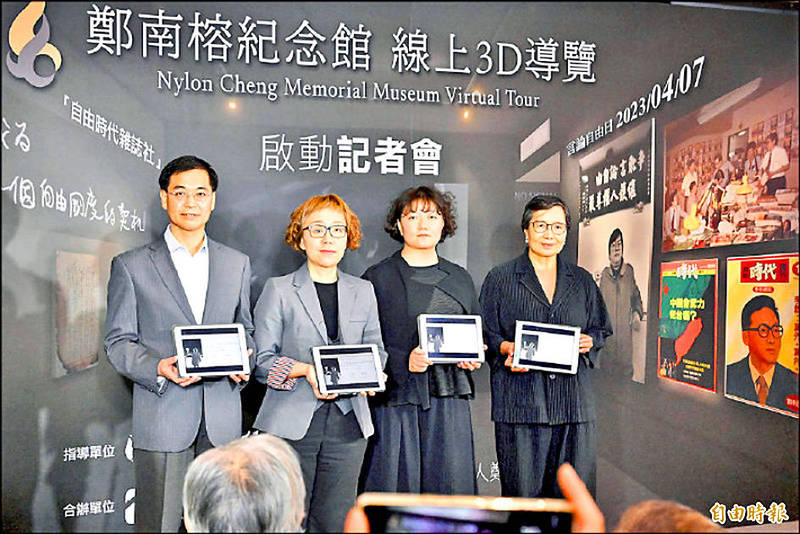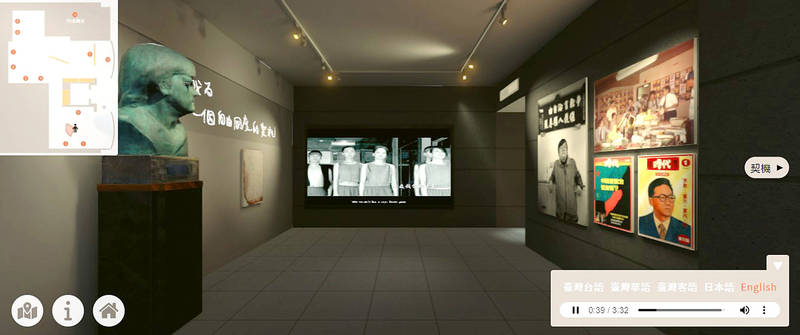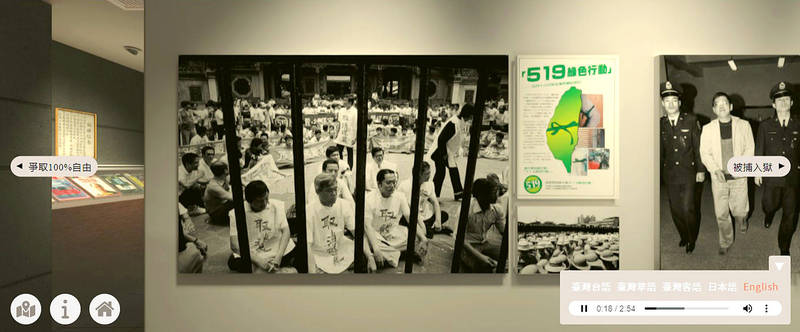《TAIPEI TIMES》 A virtual tour for free speech

From left, National Human Rights Museum director Hong Shih-fang, Deputy Minister of Culture Su Wang, Nylon Deng’s daughter Deng Chu-mei and his widow Yeh Chu-lan pose for a photo on Thursday at the launch of the 3D virtual museum dedicated to Nylon Deng. Photo: Tsung Chang-chin, Taipei Times
A 3D online museum dedicated to late political activist Deng Nan-jung was launched on April 7 to commemorate of Freedom of Speech Day
By Han Cheung / Staff reporter
There’s still no comparison between an online exhibition and visiting the actual space, but the gap is slowly narrowing — at least for information-based displays. Last Friday was Freedom of Speech Day (言論自由日) and to commemorate the occasion, the National Human Rights Museum (國家人權博物館) launched a 3D web museum dedicated to Deng Nan-jung (鄭南榕).
Deng, an outspoken proponent of freedom of expression, democracy and Taiwanese independence, self-immolated in his Freedom Era Weekly (自由時代) magazine office on April 7, 1989, just as the authorities and secret police were about arrest him for sedition. Although martial law had been lifted two years earlier, much of the government’s controls on society were still in place, and there was still a long way to go for Deng to achieve his goal of “100 percent freedom of speech.”
Regarding the museum, Deng’s widow and current presidential advisor Yeh Chu-lan (葉菊蘭) says she never thought that 34 years later, the destroyed magazine office that the authorities tried so hard to shut down would be seen by the world through the Internet.
“This piece of history needs to be told over and over to remind future generations how precious freedom is,” she said at a press conference on Thursday last week.
The online museum contains videos, pictures, art and artifacts detailing Deng’s life and ideals, reminding viewers of how grim things were just three decades ago and how far people would go to resist authoritarianism. The entire exhibition is in Chinese, but there’s an informative audio guided tour in Mandarin, Hoklo (commonly known as Taiwanese), Hakka, Japanese and English. I didn’t expect the detailed stories behind every displayed object to be translated into English, but organizers could have at least translated the titles into English.
As usual, navigating the space with a mouse and keyboard is the biggest obstacle. It’s better than many online exhibitions I’ve seen, but it’s still a bit clunky and hard to move around easily, especially since the space is quite cramped. The 3D modeling is detailed and well-done, however, and the exhibition route is intuitively designed. One problem is that it seems to be impossible to turn off the music.
It’s much easier just to follow the guided tour, which takes about 50 minutes. Most striking are the charred remains of Deng’s office, where one can click on various surviving objects and learn about their significance. For example, he swapped his wooden table for a metal one at one point to prevent the fire from spreading, and also obtained a stationary bicycle so he could exercise during the 71 days he barricaded himself indoors to avoid arrest.
In addition to the main events in Deng’s life, the guide also provides historical context and connects the events to the present. Although today people can freely discuss their political positions and criticize the government, Taiwan is often censored on the international stage and its existence denied due to pressure from China.
“Some Taiwanese self-censor at home, others struggle to articulate who we are when we’re abroad,” the guide says.
How to prevent and handle disinformation remains a major issue, and many problems remain regarding diversity, equality, justice and human rights. The exhibition leaves viewers with Deng’s last words: “What is left is up to you all.”
The physical museum is located at former magazine headquarters at 3F, 11, Ln 106, Alley 3, Minquan E Rd Sec 3, Taipei City (台北市民權東路三段106巷11號3F).
TAINAN EVENTS
‧ Tainan City was the first to designate April 7 as Freedom of Speech Day in 2012, five years before it became a national observance. The city will be holding a series of events to commemorate the occasion.
‧ An art exhibition dedicated to Deng will run until Sunday at Punplace (胖地, 21 Nanmen Road, Tainan City, 台南市南門路21號) and surrounding stores, and there will also be displays at Tainan Cultural and Creative Park (臺南文化創意產業園區) until May 21.
新聞來源:TAIPEI TIMES

Screenshot of the virtual museum dedicated to freedom of speech and democracy pioneer Deng Nan-jung. Photo: Screenshots of vitrual museum

Screenshot of the virtual museum dedicated to freedom of speech and democracy pioneer Deng Nan-jung. Photo: Screenshots of vitrual museum

Screenshot of the virtual museum dedicated to freedom of speech and democracy pioneer Deng Nan-jung. Photo: Screenshots of vitrual museum



















